Last month, the U.S. Supreme Court ruled that the Trump administration’s first attempt to terminate Deferred Action for Childhood Arrivals (DACA), in September 2017, was unlawful. Today, 25 days after the decision, the Supreme Court will certify its judgement in the case, and—under the law—the U.S. Department of Homeland Security (DHS) will have an unambiguous obligation to fully reinstate DACA. As a result, not only must the agency continue processing renewal applications by those who currently hold DACA, but it must also reopen the application process to more than 300,000 new applicants who are eligible under the terms of the program, including 55,500 of the youngest DACA-eligible individuals who have aged into eligibility over the past three years and will now be able to apply for the first time.
Notwithstanding the Supreme Court’s decision to vacate the administration’s 2017 DACA rescission memorandum, U.S. Citizenship and Immigration Services (USCIS) has taken no public steps to restore DACA to the way it operated pre-rescission. Rather, the agency has been silent—with exception of a post-decision statement that opened by questioning the legitimacy of the Supreme Court itself. As of the date of publication, the Trump administration is in open defiance of the law.
More than 825,000 immigrants have benefited from DACA’s protections
Over the past eight years, more than 825,000 undocumented immigrants who arrived in the United States as children have held protection from deportation and work authorization with DACA. Under DACA’s protection, these individuals have made great strides; they have pursued higher education, advanced their careers, enlisted in the military, and become more civically engaged members of their communities. Alongside their neighbors, more than 200,000 DACA recipients are keeping the country safe as front line workers in the COVID-19 pandemic, including the nearly 30,000 recipients who are health care workers. DACA is also immensely popular, with nearly 9 in 10 Americansexpressing support for allowing these young people and other Dreamers to remain in the country.
The stakes of the Supreme Court’s ruling
The Center for American Progress estimates that more than 1.1 million undocumented immigrants meet the basic DACA requirements—including being under age 31 as of June 15, 2012. Given that 825,000 immigrants have held DACA at some point during the program’s existence, that leaves approximately 300,000 young immigrants who should be able to apply for a first grant of DACA in light of the Supreme Court’s recent ruling.
Equally important, these data include 55,500 young people who have turned 15 in the nearly three years since the Trump administration illegally rescinded the initiative, meaning they have now aged into eligibility. This includes nearly 12,000 young people in Texas and 10,500 young people in California alone. Because the Trump administration denied these young people the opportunity to apply for DACA, they never established a direct reliance on DACA’s protections. During this time, however, many of them undoubtedly saw opportunities open up for their older siblings, peers, and classmates, as well as other people in their communities. Once they are allowed to apply, the data show that it will not take long for them to see DACA’s benefits.
Professor Roberto Gonzales, who has long studied DACA recipients, explains that within the first year after DACA began, DACA recipients were “already taking giant steps. They found new jobs. They increased their earnings. … And they began to build credit through opening bank accounts and obtaining credit cards.” Young people who obtained DACA in high school—as would be the case for most of those who have aged into the program since September 2017—experienced an “immediate change in their motivation; attending college and working in their dream fields had become a real option for them.” Just as DACA has been a lifeline for hundreds of thousands of young people over the eight years of its existence, it should also be a lifeline for these youngest eligible applicants.
55,500 young people should now have the ability to apply for DACA for the first time
Number of undocumented young people who meet DACA eligibility requirements and have turned age 15 since September 2017

Conclusion
With public statements indicating that the administration is committed to trying a second time to end DACA and reports that the rescission would take place last week, the Trump administration has yet to comply with the court ruling in any way. Today, the administration should announce that it will end its attacks on DACA recipients and reopen the program to new applicants. Additionally, the Senate should take up and pass H.R. 6, the American Dream and Promise Act, which would provide permanent protections to Dreamers and those with Temporary Protected Status. Passing the bill would finally give DACA recipients the peace of mind that, after eight years, they—and the country at large—so badly need.
Nicole Prchal Svajlenka is the associate director of research, Tom Jawetz is the vice president, and Philip E. Wolgin is the managing director for the Immigration Policy team at the Center for American Progress.





